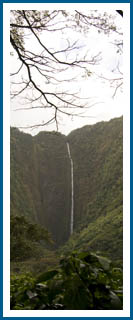
 |
 |
May 2009 Field TripBy Barbara KennedyThe Bishop Museum together with 22 students from Kanu o ka ‘Aina (KANU) charter school located on the Island of Hawai‘i gathered together for their final field trip to Waipi‘o Valley, Hawai‘i. The project included students from grades 6-11 under the expert guidance of lead teacher (kumu) Nalei Kahakalau. This field trip benefited from the addition of KANU kumu, Scott Plunkett and KiTeya Belford-Smith, as well as other supporting KANU/KALO staff. Along with Bishop Museum, DLNR-Department of Aquatic Resources Division, and other scientists, the students of KANU measured the impact of a one hundred percent (100%) stream flow restoration in Waipi‘o Valley and its surrounding environment. To accomplish this, the students and kumu participated in three days of activities that included visits to Hi‘ilawe stream on the first day, Lalakea Stream the second day, and the Muliwai (stream estuary) on the last day. On May 25th 2009, David Preston, Keith Arakaki, Clyde Imada, Ron Englund, LaVonne Englund, and I arrived in Hilo, HI. We gathered our luggage and headed over to the base yard of the Division of Aquatic Resources to retrieve our water study equipment and touch base with the staff there. Our next task was to purchase field supplies and food for the next three days of fieldwork. We then headed towards Honoka‘a town to get some gas for the generator becuase the house we have been staying at throughout this year’s study had no electricity or running water. As it turned out Mr. Byron Thomas, the owner of a home we had used in the past while in Waipi’o Valley, had built a second dwelling located where he could connect to electricity. The new place had plumbing with an indoor bath and toilet. A great improvement over the usual spartan amenities the kalo farmers of Waipi‘o are used to. Having expressed our gratitude to Byron, we settled in and arranged our gear for the next morning when the KANU students and kumu would meet us at their campgrounds known as Ku’s Place. The morning came sooner then we expected, so after a quick breakfast we collected our gear and drove over to Ku’s Place. The roads in the Valley are paved only up to the crossing at Hi‘ilawe Stream. We then encountered a very slick and slippery muddy road that passed the old Araki Hotel that is now no longer in use. The road continues to a steam bead that becomes the actual ‘road’ to Ku’s. We were met by several of the older students that have been working on the Waipi‘o Stream restoration project for several years now and treat us like close family. The kumu and some of the student’s parents greeted us as we talked and prepared for the visit to Hi‘ilawe Stream. The activities at Hi‘ilawe consisted of measuring stream flow, water quality testing, random sampling of stream invertebrates, and stream mapping. The older students that were now expert in these activities mentored the younger students, allowing the kumu to intervene only when they had any difficulty, which was very infrequent. The students were broken up into three groups. The first group measured stream flow and water quality while the second participated in invertebrate sampling. T last group did stream mapping. The groups would then rotate and undertake othe activities until about noon when we stopped for lunch. A final rotation was done after lunch and we finished around 4pm. We all gathered around for some discussion about the day’s activities and all had an opportunity to comment on their experiences that day. On the next day we met and drove up and out of the Valley to a site located at Lalakea stream. This stream is the source of Hi‘ilawe Falls, which are the headwaters of Hi‘ilawe Stream. There is a diversion at this site giving the students an opportunity to sample and take measurements above and below the diversion. In past years some of the older students were able to do measurements while the stream was still being diverted. These same students were able to give the younger students a different perspective as to how the stream had changed before and after the restoration of the flow. The activities at Lalakea mirrored those at Hi‘ilawe the first day giving the student a comparison between the lower elevation Hi‘ilawe and upper elevation (2000’) Lalakea Stream. By the third day we were looking forward to a change in activities. The muliwai (stream estuary) provided an activity that most of the student could not resist, swimming. With the use of equipment borrowed from the Division of Aquatic Resources (Hawaii Department of Land and Natural Resources), the students collected native and alien aquatic animals. Mostly fish, but a few frogs, toads, and native shrimp were also collected. The goal of this activity was to assist the Hilo DAR biologists with and alien fish count and determine the impacts of removing non-native species from the muliwai in an effort to increase the native fish populations. Of course once the work was done it was playtime. Swimming was in order. As this was the final fieldtrip of the project the students were lamenting the possibility of continuing the study. Some of these students have been participating in the Waipi‘o Stream Restoration Project since 2003 when the study first developed. We have basically grown into a very large extended family looking forward to the next visit. We at the Bishop Museum greatly admire and appreciate all the students and kumu that we have interacted with over the last year and we will continue with the Stream Project in whatever form it takes in the future. Top of Page |
|
| Copyright © Hawaii Biological Survey, Bishop Museum Site last updated January 2010 |
||